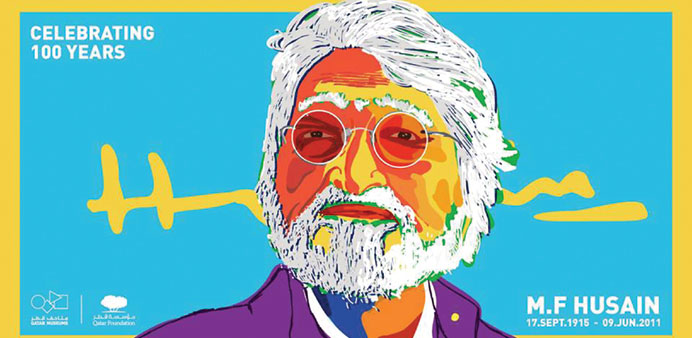RETROSPECTIVE: Qatar Museums’ logo to celebrate M F Husain’s 100th birthday.
Qatar Museums pays tributes to the life and work of the celebrated
artist, who made Doha his home in the years before his death, so as to
celebrate what would have been his 100th birthday. By Anand Holla
Celebrated Indian artist M F Husain’s bond with Qatar was special, to say the least. Soon after 2006, when he would travel between UAE and UK as part of a self-imposed exile following a controversy over his paintings back home, the prolific painter chose to post himself in Doha and went on to create another set of fascinating new work.
Through the week, Qatar Museums (QM), through its social media platforms and institutions, has highlighted the life and work of the man often referred to as The Picasso of India, so as to celebrate what would have been his 100th birthday. At Virginia Commonwealth University in Qatar, for instance, there was a screening of Husain’s film Gaja Gamini on Thursday evening.
QM also urged its followers to go through a holistic biography of Husain penned by Dr Dina Bangdel, on the Mathaf Encyclopedia of Modern Art and the Arab World – a free online scholarly comprehensive resource that provides basic facts and in-depth information on modern art of the Arab world.
A self-taught artist, Husain, who was born in Pandharpur in Western India and grew up in Indore in Central India, was 22 when he moved to Bombay and began working as a billboard painter for Indian movies. He then enrolled himself at the esteemed J J School of Arts in Bombay for a year, and soon, his paintings began gaining appreciation from his contemporaries.
Post the partition of India, a group of young avant-garde Indian artists formed the Bombay’s Progressive Artists’ Group (PAG) in December 1947; Husain was its founding member, along with F N Souza, S H Raza, K H Ara, H A Gade and S Bakre.
Bangdel, who is Director, Art History Programme, VCU-Q, writes, “The PAG artists were conscious of their diverse cultural backgrounds –Christian, Hindu, Muslim, and Dalit (untouchable) – a collective coming together in search of new modernist idioms to represent the ‘independent India as a democratic, secular, and multi-ethnic nation.’ Therefore, Husain’s career is representative of Indian modernity, focused on pluralism and secularity.”
Bangdel continues, “Even though he was a Muslim, he identified himself as an Indian artist, basing his visual language on the roots of the rich Indian civilisation, including Hindu mythological narratives. In short, Husain represented the ideal of India as a nation-state: modern, secular, and multicultural.”
Bangdel points out how even in his early works from the 1950s and 1960s, Husain defined the trends of modernism in India – “a desire to create a new visual metaphor, which combined international modernist conventions with themes that were local and culturally derived,” and that he established himself as a figurative artist with a modernist twist using a cubist visual language derived from European modernism. “In contrast, his subjects of mythology, politics, and history were intimately connected to his Indian roots and his personal interests,” she says.
“Over the years, Husain continued his artistic experimentations in figurative abstraction and cubism, yet his subjects were deeply connected to his Indian roots and his own self-identity as both a Muslim and Indian,” writes Bangdel, pointing out that Husain is said to have painted over 30,000 works in a range of media and across a range of subjects.
From the Hindu epics of the Ramayana and Mahabharata, his calligraphic Sufi series from the 1970s and 1980s, to his Christian series of the Last Supper, and his later commissions on Arab/Islamic civilisation and history, Last Supper in the Desert (2008) or Cross-Cultural Dialogue (2008), Husain’s range is staggering. “He is the pre-eminent Indian modernist artist, whose work Empty Bowl at the Last Supper (2005) sold for $2mn in 2005, setting a world record for any South Asian modern and contemporary artist,” Bangdel writes.
While in Doha, Qatar offered Husain Qatari citizenship, which he accepted in 2010. Subsequently, he lived in Doha, and continued to work on a major commissioning by HH Sheikha Moza bint Nasser to create a series of 99 paintings, symbolic of the Asmaa’ Allah al-Husna (the 99 Beautiful Names of Allah).
Husain completed 34-35 paintings of the series before he passed away. The biography concludes, “This extraordinary figure of Indian modernism, often called the ‘barefoot artist’ due to the fact that he had reportedly not worn shoes since 1964, died in London in 2011, at the age of 95.”


